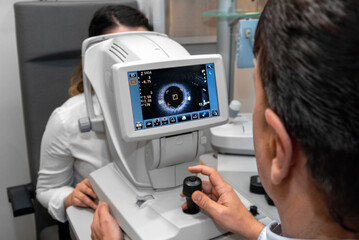Seeing is Believing: Experience Excellence at Our Vision Care Center
We offer comprehensive vision/eye care, state-of-the-art treatments and surgeries, and an extensive selection of eyeglasses and contact lenses. We also provide cosmetic dermatology services such as Botox, Dysport, Fillers, Kybella, and more. At NYEE, we make it easy for patients to manage their vision health through online registration, payment, and forms. Contact Maryland Eye Care Center now!
In many countries eye diseases (such as conjunctivitis, mild trauma and watery eyes) are among the most common problems presenting to primary level health workers. These workers need to be able to identify the conditions they can treat themselves, and which they should refer for more detailed examination, treatment and referral at secondary and tertiary levels of health care.
An ophthalmologist is a medical doctor who is trained to diagnose and treat complex eye diseases such as cataracts, glaucoma and others using medicine or surgery. After medical school, ophthalmologists must complete a 1-year internship and 3-4 years of residency. Then they are board certified. They can also provide medical treatment for eye diseases that glasses or contacts, such as retinopathy from diabetes or macular degeneration cannot correct. Other specialties include:
- Pediatric ophthalmology, which treats children’s eye disorders.
- Low-vision optometry, which provides devices and strategies to help people with vision impairments.
- Neuro-optometry, which deals with eye issues caused by brain or optic nerve problems, such as drooping eyes and uncontrolled blinking.
They can also treat ocular oncology, which treats cancers of the eye and the socket.
Optometrist
An optometrist is the eye doctor you see for your regular comprehensive eye exams. These healthcare professionals are the best qualified to diagnose and treat eye diseases, including glaucoma and macular degeneration, as well as general health issues that may be related to the eyes. They also prescribe glasses and contact lenses.
Optometrists are licensed to practice in all aspects of optical and medical eye care. They conduct comprehensive eye exams and prescribe corrective lenses to aid refractive errors such as myopia, hyperopia, astigmatism, and double vision. They can also identify and treat amblyopia (lazy eye) in children. They are also trained to diagnose and manage eye disease such as ocular infections, inflammation and glaucoma, as well as their associations with systemic health. They are trained to prescribe all topical medications for eye care and ocular emergencies, as well as some oral medications.
In addition to providing vision services, optometrists are often involved in research practices, and provide training for new eye care professionals. They participate in awareness programs such as Vision 2020, a worldwide campaign to prevent avoidable blindness. They also visit schools, colleges and occupational areas to carry out eye examinations and prescribe glasses.
Unlike an ophthalmologist, who must complete undergraduate education and four years of medical school to become a medical doctor, an optometrist is licensed to practice after four years of optometry school and an internship. Optometrists must continue their education to stay up-to-date on the latest advances in eye care and optometry.
Aside from a four-year degree, the most significant difference between an optometrist and an ophthalmologist is the level of training that each receives. Optometrists typically have the shortest training, which is about a year or two after graduating from high school.
An ophthalmologist, on the other hand, is a medical doctor who spends eight years in medical school and at least three to four years in a residency after graduating from college. They are trained to perform complex surgeries and can treat a wide range of eye conditions, including cataracts, diabetic retinopathy, glaucoma and macular degeneration.
Optician
Opticians are a critical member of a patient’s eye care team, focusing on dispensing eye wear according to prescriptions provided by ophthalmologists and optometrists. They work with patients to select frames and lenses that meet their visual, occupational, and lifestyle needs. They may also recommend low vision aids or vision therapy. They also write work orders to help ophthalmic lab technicians correctly fill prescriptions and dispense the final eyewear. Opticians can be found working in a variety of settings, including medical offices and retail locations. Those who are most successful in this role tend to be goal-oriented and extroverted.
An ophthalmologist is a medical doctor who can treat complex eye problems with medication, surgery, and other treatments. They often specialize in specific areas of eye care, such as glaucoma or retinal disease. They are able to perform a comprehensive medical eye exam, which is the first step in diagnosing an eye condition. An ophthalmologist can prescribe eyeglasses, contact lenses, and medications to improve vision and correct eye conditions.
A qualified ophthalmologist can diagnose and treat a wide range of eye-related issues, including cataracts, glaucoma, corneal disease, and dry eyes. They can also offer advice on healthy eating and exercise, and prescribe medications to prevent dry eye symptoms. Some ophthalmologists also perform eye surgeries, such as removing cataracts or correcting misaligned eyesight.
You should see an ophthalmologist for any severe or changing eye symptoms, such as a sudden loss of vision. A reputable ophthalmologist will refer you to the right specialist for any further care that’s required.
While an optometrist can provide many aspects of eye care, they are not qualified to diagnose and treat any underlying health or medical problems. This is why ophthalmologists are always the first point of contact for anyone who has an eye-related problem.
To become an optician, you must complete a program that’s accredited by the Commission on Opticianry Accreditation. The curriculum includes a combination of classroom learning and hands-on clinical experience. During the coursework, you’ll learn about optical principles and terminology, lens fabrication, ophthalmic physics, and the anatomy of the eye. You’ll also learn to use a number of different ophthalmic instruments, including an autorefractor and an auto-keratometer.
Assistant
An assistant eye doctor is the person who performs various tasks to help patients see and look their best. Their job is to ensure that the patient’s experience at the eye doctor’s office is as comfortable as possible, while also ensuring that all of the patient’s questions are answered. They are a vital member of the team and have a huge impact on how a patient views their doctor. They are also responsible for a variety of administrative duties, such as scheduling appointments and exams and processing transactions. They must be knowledgeable about common medical terms and procedures. They must also be able to answer basic patient questions over the phone and in person.
A career as an optometric assistant is rewarding and exciting. These professionals work directly with optometrists to provide a wide range of services to their patients. They can take a patient’s case history, schedule appointments and examinations, and prepare test equipment. They also handle insurance and payment matters. In addition to their administrative duties, optometric assistants often assist with vision tests. This includes testing a patient’s ocular pressures, using autorefractors to estimate a patient’s prescription, and running visual field screening tests.
Many people start this career as receptionists or office administrators in an optometry practice, then receive on-the-job training as they move through the ranks of the profession. However, some schools also offer formal training programs for those who wish to enter the field.
While the job description for an ophthalmic assistant is diverse, some of their specific duties include:
Reviewing a patient’s chart to ensure that all necessary data is entered in the system before a patient arrives. Taking a patient’s case history, including information such as previous eye issues and the medications they are currently taking. Scheduling appointments, including booking, rescheduling, and cancelling them. Communicating with patients over the phone, including answering questions, addressing concerns, and scheduling appointments.




